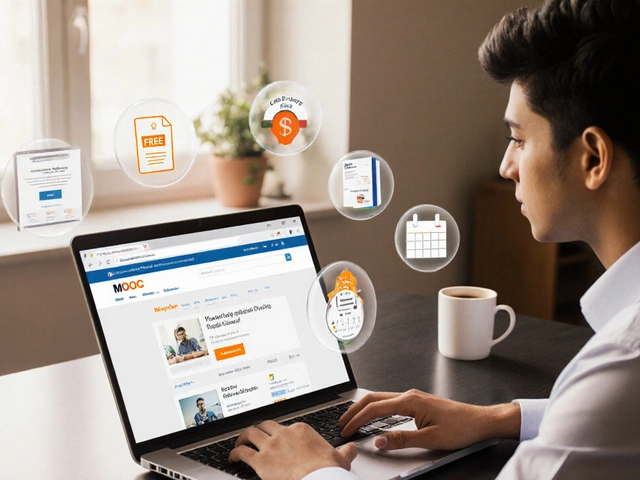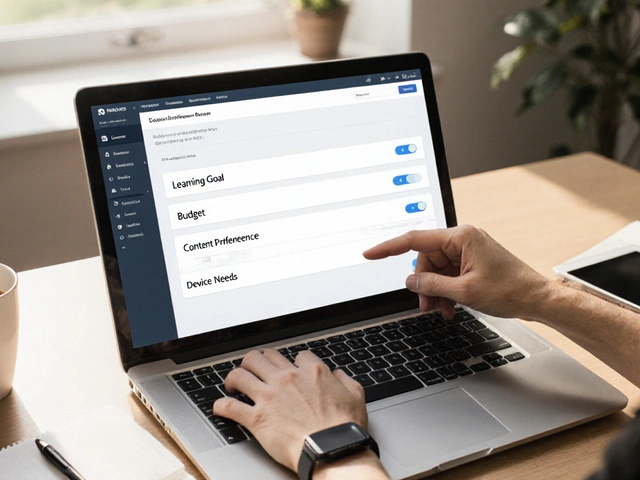
Google's education platform has become a staple in the world of e-learning, and honestly, it's not surprising. With tools like Google Classroom leading the charge, both teachers and students have found themselves with a whole new set of resources at their fingertips. But what exactly does this platform offer, and how can you make the most of it?
At its core, Google's education platform is about accessibility and simplicity. It's designed to make learning and teaching as smooth as possible, regardless of whether you're in a bustling classroom or learning from home. The beauty of it lies in its integration with other Google tools, like Docs and Drive, making file sharing and collaboration practically seamless.
For those who embrace digital education, this platform offers a superb blend of traditional classroom elements with cutting-edge technology. It's not just about replicating the classroom online; it's about enhancing it with possibilities that weren't possible before, such as real-time feedback and interactive assignments. Whether you're a tech-savvy teacher or a student ready to tackle the next big project, there's plenty here for you to explore.
- Overview of Google’s Education Platform
- Key Features You Should Know About
- How Teachers and Students Benefit
- Integration with Other Google Tools
- Real-World Applications
- Tips for Getting the Most Out of It
Overview of Google’s Education Platform
If you've ever thought about how things might get simpler in the classroom, you're not alone. Google's education platform is a part of the online education revolution, making teaching and learning easier and more interactive. At the heart of this platform is Google Classroom, which acts like a virtual hub for assignments, communication, and collaboration.
So what’s the big deal about Google’s approach? For starters, it’s the integration. Google’s offerings like Drive, Docs, and Slides mean everything is connected. Teachers can assign work in Docs, students can collaborate using Slides, and sharing happens seamlessly through Drive. Plus, both teachers and students love how everything's stored safely in Google's cloud.
“Google Classroom is one of the most simple yet powerful educational tools available. It’s designed to let teachers focus on teaching instead of tech support,” says Emily Brown, an education tech expert.
But let’s not forget about accessibility. The platform is available on practically any device with an internet connection. Whether you’re at home or on-the-go, Google’s got your back. This cross-device capability ensures that learning never has to stop because of tech glitches or compatibility issues.
Schools are noticing the benefits too. The flexibility of Google’s education tools can help adapt to different teaching styles and learning speeds, making personalized education a reality, not just a buzzword. It’s an evolving space, and Google seems set on making education more available and effective worldwide.
Key Features You Should Know About
Diving into Google's education platform, the Google Education Platform offers a bunch of handy features that really make online learning more interactive and effective. First off, there's Google Classroom. This is basically the hub where teachers and students meet in the virtual world. It streamlines assignment distribution, grading, and communication, which is a lifesaver in keeping everyone on track.
One of the major highlights is the integration with other Google tools. Think seamless access to Google Drive, Docs, Slides, and Sheets. Need to submit an essay or work on a group project? These tools make it ridiculously easy. Plus, collaborative features mean multiple people can work on a document at the same time, with changes syncing instantly.
Another cool feature is the ability to provide real-time feedback. Teachers can leave comments on students’ work as they're doing it. This means students get immediate tips on how they're doing, which is super valuable for learning.
- Google Meet Integration: Virtual classes and meetings are just a link away, making the platform great for live sessions.
- Gradebook: Helps teachers keep track of grades, which students can access to see where they stand.
- Quizzes and Assignments: Setting up quizzes is not only easy but also efficient with automatic grading options.
And let's not forget security. Google takes privacy seriously, so their platform incorporates strong protection protocols to keep student data safe.
To give you a picture, here's how the use of Google Classroom evolved over the years:
| Year | Number of Users |
|---|---|
| 2015 | 10 million |
| 2020 | 100 million |
| 2023 | 150 million |
It's clear that the Google Education Platform empowers educators and learners by making the learning process less about tech struggles and more about actual studying.
How Teachers and Students Benefit
The benefits that Google's education platform offers to teachers and students are pretty impressive. This isn't just about making teaching and learning convenient; it's about amplifying them with new possibilities that simplify everyday tasks and spark curiosity.
For teachers, the platform streamlines class management. Google Classroom, for instance, allows educators to organize assignments, provide feedback, and assess student progress without drowning in paperwork. Offering everything from automated grading to a centralized hub for resources, it frees up time for teachers to focus on what truly matters—student engagement and learning.
Students, on the other hand, are getting a more interactive experience. With features like real-time collaboration on Docs, they can work together no matter where they are. This not only boosts cooperation but teaches invaluable skills for the modern workplace. Access to resources anytime and anywhere means they're no longer tethered to a textbook; the learning opportunities are endless.
Another cool perk for both parties is the integration of other Google services. Need to schedule a parent-teacher meeting? Google Calendar's got you covered. Want to show a YouTube video as part of a lesson? Easy peasy. Everything works together smoothly, reducing tech headaches.
Online education via Google's platform also narrows the gap for students with different needs. It provides features for accessibility, like screen readers and captions, ensuring every student has a chance to succeed. Plus, teachers can tailor instructions to fit individual learning paces, transforming the traditional one-size-fits-all model.
Overall, Google's education platform opens up a new world where the conventional barriers of time and place start to fade, leaving behind a collaborative, efficient, and inclusive learning environment that's beneficial for all participants.

Integration with Other Google Tools
If you're diving into the world of Google's Education Platform, one of the coolest things you'll find is how it seamlessly integrates with other Google tools. This isn't just about convenience; it's about creating a smoother, more effective learning and teaching experience.
One of the biggest hustles for teachers and students is managing documents. With Google Drive, organizing files becomes a breeze. Everything you need, from assignments to lecture notes, is just a quick search away. Plus, collaborating on projects? Piece of cake. Students can work on shared documents in Google Docs without a hitch – tracking changes and leaving comments in real-time.
Then there's Google Calendar. It's a lifesaver for managing due dates and class schedules. By linking class events, everyone stays on the same page, and the risk of missing important deadlines drops significantly.
According to TechCrunch, "The integration of tools like Google Drive and Google Docs into the classroom has transformed how educators manage their digital tasks and increased their efficiency dramatically."
Let's not forget about Google Meet. In today's online-offline hybrid world, having a reliable video conferencing tool is crucial. Whether it's for remote classes or virtual office hours, Google Meet ensures that face-to-face interactions continue without a hitch.
| Tool | Purpose |
|---|---|
| Google Drive | File management and storage |
| Google Docs | Document collaboration and editing |
| Google Calendar | Schedule management |
| Google Meet | Video conferencing |
With these integrations, the Google Education Platform doesn't just work as a standalone tool; it becomes part of a larger ecosystem that enhances every aspect of online education. So, when you're working with Google's suite, you're not just using tools; you're optimizing your learning and teaching environment to the fullest.
Real-World Applications
Now, let's see how Google's education platform is put to work in real-world scenarios. This isn't just a set of digital tools for fun; it's designed to solve actual problems in education and enhance learning experiences everywhere.
First up, Google Classroom has become a lifesaver for teachers and students who are no longer confined to traditional classrooms. It allows educators to post assignments, grade, and provide feedback all in one spot. This means even if you have students from different parts of the globe, teaching synchronously or asynchronously becomes a breeze.
Another neat feature of the platform is its accessibility options. Teachers can use it to create differentiated assignments catered to various learning levels, which is especially handy for special education programs. Thanks to these features, a teacher can provide tailored content, ensuring that no student gets left behind.
In higher education, universities are making good use of the platform's collaborative tools. For instance, group projects can utilize shared Docs and Slides for real-time collaboration, regardless of where the students are physically located. This kind of seamless interaction fosters a sense of teamwork even from afar.
Let's not forget about the organizational aspect. School admins love it because it helps them manage communications efficiently. They can streamline messages and announcements to keep everyone informed without the dreaded email overload.
If we're talking numbers, then check this out: A recent survey found that schools using the platform reported a 30% increase in student engagement due to its interactive elements. And that doesn't even count the time saved by cutting down on paper assignments.
Overall, Google's Education Platform is reshaping how education is approached, making it more flexible and accessible. Whether it's a middle school science class or a university seminar, this platform is definitely making its mark.
Tips for Getting the Most Out of It
Using the Google Education Platform to its fullest potential can really change the way both teachers and students experience learning. If you're just getting started, or even if you've been using it for a while, there are some tips that can make a big difference.
First things first, get familiar with Google Classroom and its features. It's more than just a place for assignments; it's a hub for communication and collaboration. Make sure everyone knows how to navigate it, from posting announcements to commenting on discussions.
Next up, take advantage of the integration with other Google tools. Tools like Google Docs, Sheets, and Slides allow students to work together on projects in real-time. This can really boost engagement and team collaboration.
Don't forget to customize your classroom. You can tweak the settings for notifications, grading, and class organization. A little personalization goes a long way in keeping everything organized and easily accessible for everyone involved.
- Use Google Forms for quizzes and surveys. It’s an easy way to gauge understanding and gather feedback.
- Encourage students to use tools like Google Keep for note-taking. It syncs with all Google tools, making it easy for students to keep their notes organized.
- Promote peer review by letting students comment on each other’s assignments on Google Docs. This helps build a collaborative learning environment.
If you want to see how you're doing or need to adjust your approach, use the analytics and feedback built into the platform. You can see who's engaging with the content, who's not, and make changes based on that insight.
| Tool | Use Case |
|---|---|
| Google Forms | Quizzes and surveys |
| Google Keep | Note-taking |
| Google Meet | Virtual classes and discussions |
| Google Sheets | Tracking progress and grades |
And finally, stay updated. Google often rolls out new features and updates, so keeping an eye out can help you incorporate new tools and stay ahead.







